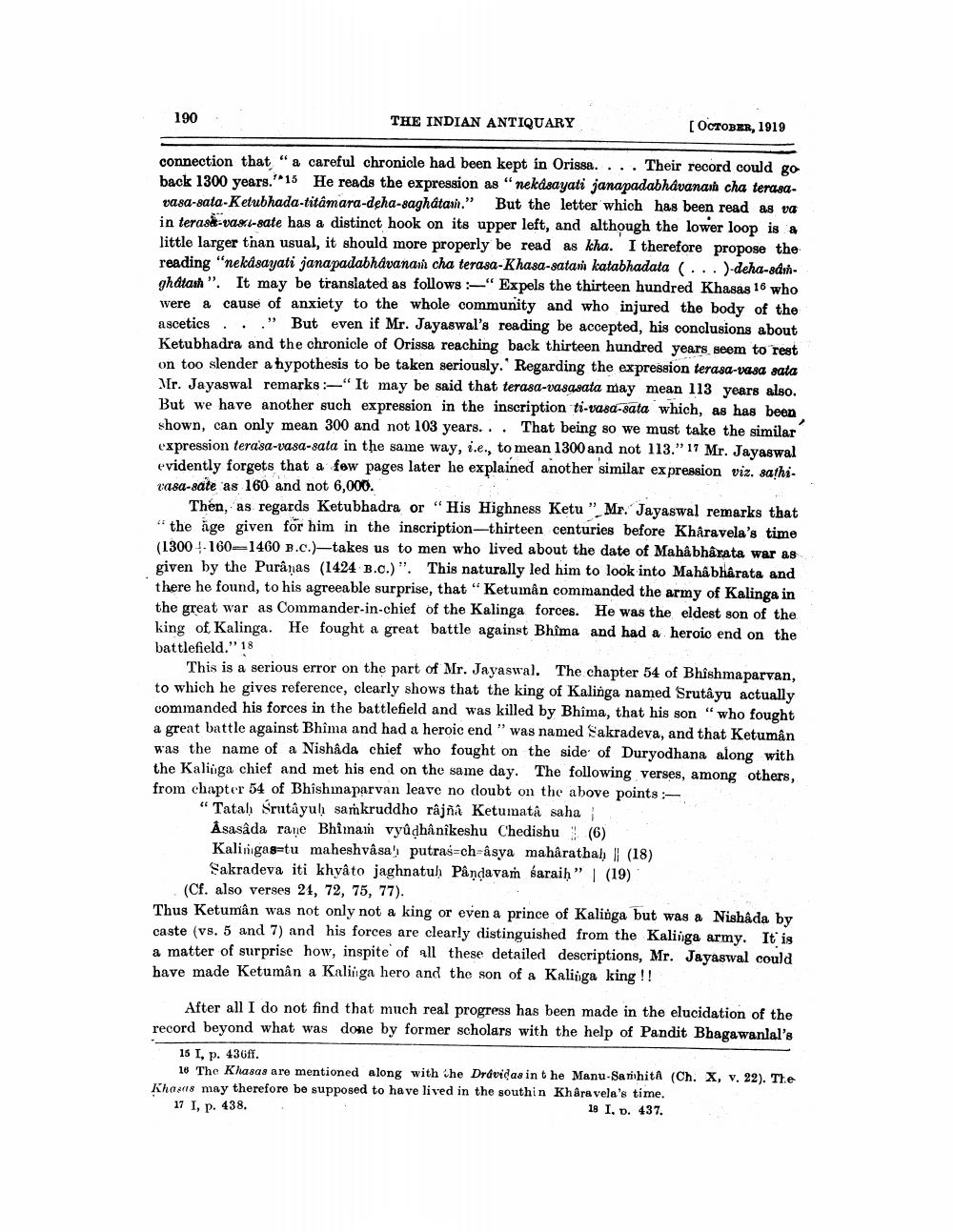________________
190
THE INDIAN ANTIQUARY
[ OCTOBER, 1919
connection that " a careful chronicle had been kept in Orissa.... Their record could go back 1300 years." 15 He reads the expression as "nekâsayati janapadabhavana cha terasavasa-sata-Ketubhada-titâmara-deha-saghátam." But the letter which has been read as va in terase-vas-sate has a distinct hook on its upper left, and although the lower loop is a little larger than usual, it should more properly be read as kha. I therefore propose the reading "nekâsayati janapadabhavanam cha terasa-Khasa-satam katabhadata (...)-deha-samghâtash". It may be translated as follows:-"Expels the thirteen hundred Khasas 16 who were a cause of anxiety to the whole community and who injured the body of the ascetics..." But even if Mr. Jayaswal's reading be accepted, his conclusions about Ketubhadra and the chronicle of Orissa reaching back thirteen hundred years seem to rest on too slender a hypothesis to be taken seriously. Regarding the expression terasa-vasa sata Mr. Jayaswal remarks:-" It may be said that terasa-vasasata may mean 113 years also. But we have another such expression in the inscription ti-vasa-sata which, as has been shown, can only mean 300 and not 103 years... That being so we must take the similar" expression terasa-vasa-sata in the same way, i.e., to mean 1300 and not 113." 17 Mr. Jayaswal evidently forgets that a few pages later he explained another similar expression viz. sathicasa-sate as 160 and not 6,000.
Then, as regards Ketubhadra or "His Highness Ketu "Mr. Jayaswal remarks that "the age given for him in the inscription-thirteen centuries before Khâravela's time (1300-160-1460 B.C.)-takes us to men who lived about the date of Mahabharata war as given by the Purânas (1424 B.C.)". This naturally led him to look into Mahabharata and there he found, to his agreeable surprise, that "Ketumân commanded the army of Kalinga in the great war as Commander-in-chief of the Kalinga forces. He was the eldest son of the king of Kalinga. He fought a great battle against Bhima and had a heroic end on the battlefield." 18
This is a serious error on the part of Mr. Jayaswal. The chapter 54 of Bhishma parvan, to which he gives reference, clearly shows that the king of Kalinga named Srutâyu actually commanded his forces in the battlefield and was killed by Bhîma, that his son "who fought a great battle against Bhîma and had a heroic end" was named Sakradeva, and that Ketumân was the name of a Nishâda chief who fought on the side of Duryodhana along with the Kalinga chief and met his end on the same day. The following verses, among others, from chapter 54 of Bhishmaparvan leave no doubt on the above points:"Tatah Srutâyuḥ saṁkruddho râjña Ketumata saha
Asasâda rane Bhimam vyûḍhânîkeshu Chedishu (6)
Kalingas tu maheshvâsa putras-ch-âsya mahârathal || (18) Sakradeva iti khyâto jaghnatuh Pândavam saraiḥ" | (19)
(Cf. also verses 24, 72, 75, 77).
Thus Ketumân was not only not a king or even a prince of Kalinga but was a Nishâda by caste (vs. 5 and 7) and his forces are clearly distinguished from the Kalinga army. It is a matter of surprise how, inspite of all these detailed descriptions, Mr. Jayaswal could have made Ketumân a Kalinga hero and the son of a Kalinga king!!
After all I do not find that much real progress has been made in the elucidation of the record beyond what was done by former scholars with the help of Pandit Bhagawanlal's
15 I, p. 436ff.
16 The Khasas are mentioned along with the Drávidas in the Manu-Samhita (Ch. X, v. 22). The Khasus may therefore be supposed to have lived in the southin Khâravela's time. 17 I, p. 438.
18 I. D. 437.




